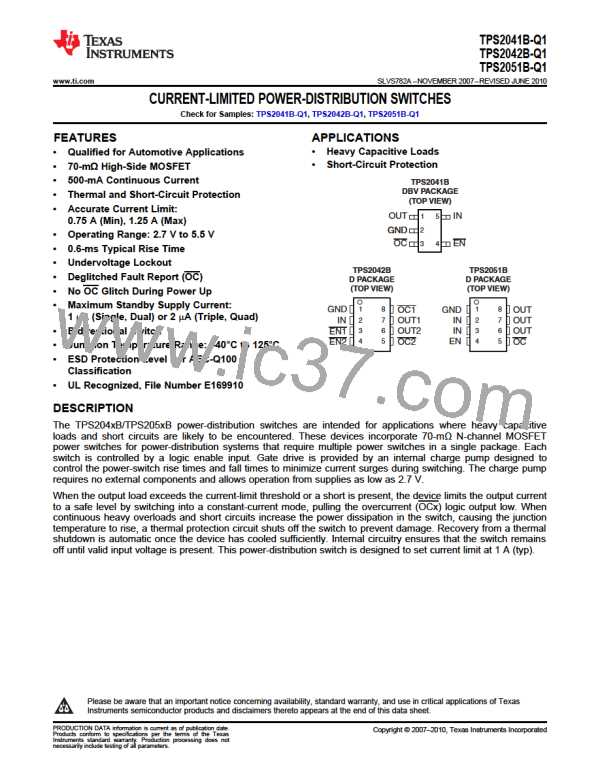TPS2041B-Q1
TPS2042B-Q1
TPS2051B-Q1
www.ti.com
SLVS782A –NOVEMBER 2007–REVISED JUNE 2010
Universal Serial Bus (USB) Applications
The universal serial bus (USB) interface is a 12-Mb/s, or 1.5-Mb/s, multiplexed serial bus designed for
low-to-medium bandwidth PC peripherals (e.g., keyboards, printers, scanners, and mice). The four-wire USB
interface is conceived for dynamic attach-detach (hot plug-unplug) of peripherals. Two lines are provided for
differential data, and two lines are provided for 5-V power distribution.
USB data is a 3.3-V level signal, but power is distributed at 5 V to allow for voltage drops in cases where power
is distributed through more than one hub across long cables. Each function must provide its own regulated 3.3 V
from the 5-V input or its own internal power supply.
The USB specification defines the following five classes of devices, each differentiated by power-consumption
requirements:
•
•
•
•
•
Hosts/self-powered hubs (SPHs)
Bus-powered hubs (BPHs)
Low-power bus-powered functions
High-power bus-powered functions
Self-powered functions
Self-powered and bus-powered hubs distribute data and power to downstream functions. The
TPS204xB/TPS205xB can provide power-distribution solutions to many of these classes of devices.
Hosts/Self-Powered Hubs and Bus-Powered Hubs
Hosts and self-powered hubs have a local power supply that powers the embedded functions and the
downstream ports (see Figure 25). This power supply must provide from 5.25 V to 4.75 V to the board side of the
downstream connection under full-load and no-load conditions. Hosts and SPHs are required to have
current-limit protection and must report overcurrent conditions to the USB controller. Typical SPHs are desktop
PCs, monitors, printers, and stand-alone hubs.
Power Supply
Downstream
USB Ports
3.3 V
5 V
TPS2051B
D+
D-
2, 3
0.1 µF
IN
6, 7, 8
V
BUS
OUT
0.1 µF
120 µF
GND
5
4
OC
EN
USB
Control
GND
1
Figure 25. Typical One-Port USB Host/Self-Powered Hub
Bus-powered hubs obtain all power from upstream ports and often contain an embedded function. The hubs are
required to power up with less than one unit load. The BPH usually has one embedded function, and power is
always available to the controller of the hub. If the embedded function and hub require more than 100 mA on
power up, the power to the embedded function may need to be kept off until enumeration is completed. This can
be accomplished by removing power or by shutting off the clock to the embedded function. Power switching the
embedded function is not necessary if the aggregate power draw for the function and controller is less than one
unit load. The total current drawn by the bus-powered device is the sum of the current to the controller, the
embedded function, and the downstream ports, and it is limited to 500 mA from an upstream port.
Copyright © 2007–2010, Texas Instruments Incorporated
Submit Documentation Feedback
17
Product Folder Link(s): TPS2041B-Q1 TPS2042B-Q1 TPS2051B-Q1

 TI [ TEXAS INSTRUMENTS ]
TI [ TEXAS INSTRUMENTS ]